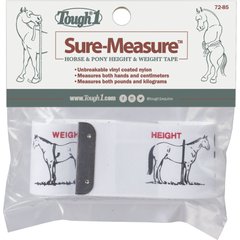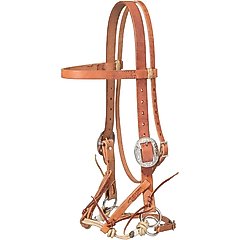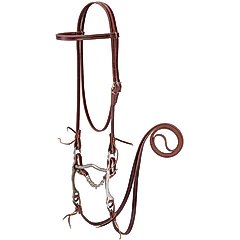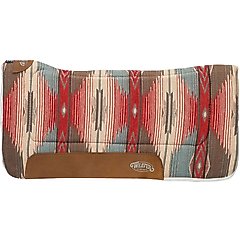How Much Weight Can a Horse Carry?
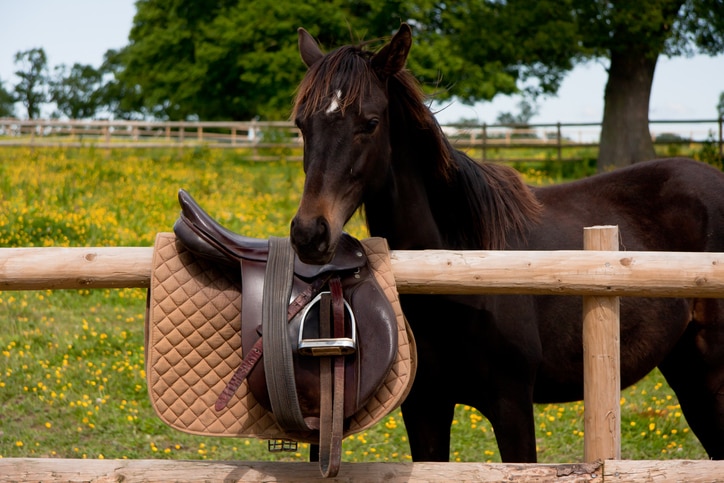
Photo by Groomee/iStock / Getty Images Plus via Getty Images
Over a century ago, the U.S. Cavalry Manual of Horse Management first published a weight-carrying guideline for horses. The manual stated that the ideal limit for how much weight a horse can carry is 20% of their body weight.
More recent research suggests that a horse’s carrying capacity is also influenced by factors like the horse’s athleticism, breed and conformation, and the rider’s skill level. It’s always recommended to work with your veterinarian and trainer to determine how much weight your horse can successfully carry.
How Much Weight Can Horses Carry?
The general rule for how much weight a horse can carry is the equivalent of 20% of the horse’s body weight, including the rider, tack, and equipment.
That means a 1,000-pound horse can comfortably carry about 200 pounds. If you’re unsure how much a horse actually weighs, you can use a handy weight tape like the Tough1 Sure Measure Horse Height & Weight Tape.
Recommended Product
When equine nutritionist and physiologist Debra M. Powell, owner of Powell Equine Canine Therapy Services, was an associate professor at Ohio State University, she and colleagues had thoughts about the safety and welfare of the horses in the college’s lesson program.
“Because of the type of horses that we had (which were considered light riding horses) and differences in body weights of the students, we wanted to make sure that these horses could safely carry the rider,” she says.
They designed a study to simulate a 45-minute working session of an intermediate riding lesson horse. They observed eight light-breed horses carrying 15, 20, 25, and 30% of their weight while exercising at a walk, trot, and canter.
In addition to monitoring heart rate, the researchers drew blood samples before work, 10 minutes post-exercise, and 24 hours later to evaluate plasma lactate concentration (level of lactic acid in the bloodstream, which indicates blood flow through tissue) and serum creatine kinase (CK) activity.
CK is an enzyme found in the heart and skeletal muscle that produces energy in the muscles during exercise. CK levels can indicate muscle damage or overload. The researchers used the results to develop a justifiable rider weight limit policy for their lesson horses.
“Based on our study, we found that the weight load should not be in excess of 20% of the horse’s body weight for light riding horses,” she says. “Based on work rates, heart rates, lactate concentration, and creatine kinase concentrations, this percentage is acceptable and does not stress the horse.”
What Else Can Influence a Horse’s Weight Limit?
The 20% rule is a rule of thumb is influenced by factors including:
- Horse fitness level
- Horse body conformation
- Rider skill level
- Work intensity
- Exercise duration
- Tack fit
- Quality of hoof care
Horse Fitness Level
The more fit the horse, the more easily they can carry riders.
“Horses are not naturally built to carry a load on their backs—they are not anatomically designed for that,” says Powell. “They have to be conditioned to build up their core strength so that they are better able to support weight on their backs.”
Horse Body Conformation
How a horse is built influences their weight-carrying ability. For example, Powell’s study found that horses with larger cannon bone circumference in the leg and wider loins can better carry heavier loads. These horses experience less muscle soreness and tightness when carrying higher weight loads.
Other studies that have specifically studied Icelandic horses have found similar results—that back strength and bone density play a key role in weight carrying limits. Despite being shorter in height, Icelandic horses carry adult riders comfortably because they have muscular backs and a denser bone structure.
Rider’s Skill Level
Beginner or unfit riders tend to be more unbalanced than more experienced riders.
“An unbalanced rider is basically an unbalanced load on the horse, putting more strain on the horse to maintain [their] position or motion,” Powell says.
Hannah R. Leventhal, DVM, an assistant teaching professor of equine emergency medicine at the University of Missouri, adds, “Beginner or unfit riders should probably be riding a larger, more fit, and well-muscled horse.”
Speed, Duration, and Terrain
Riding over rough terrain, at high speeds, and for long periods of time requires horses to exert more effort. When a horse is unfit or carrying more weight than they can handle, they can fatigue faster and be at an increased risk for injury.
Factoring In Tack
Ill-fitting tack is uncomfortable and can contribute to soreness and lameness issues. Regardless of the weight a horse carries, the tack should fit properly. One study found that improper tack fit for horse and rider had the greatest impact on how much weight a horse could carry.
Ensure saddles, bridles, and other pieces of tack fit properly, and use a horse saddle pad or blanket under the saddle to alleviate pressure points on your horse’s back.
Recommended Products
Hoof Care Considerations
Imagine trying to run a marathon in stiletto heels. Your balance will be off, and carrying a weighted backpack would make it worse. Unmaintained hooves create a similar effect on horses.
“Keeping tabs on the horse’s feet and making sure they’re well-trimmed and well-cared for is important,” says Dr. Leventhal.
What Happens If a Horse Carries Too Much Weight?
More research exploring the impact of asking a horse to carry too much weight is needed. However, existing studies and field observations show that if a horse carries too much weight, it may take them longer to recover from exercise. They may also become achy and exhibit behavior changes.
Carrying too much weight can cause several symptoms in horses. Let’s look at the most common ones.
Muscle Soreness
Powell’s study showed that horses with higher weight loads exhibited greater muscle soreness and tightness 24 hours after exercise completion. The horses carrying 30% of their body weight showed the highest muscle soreness and tightness levels 24 hours post-exercise.
“Horses carrying 30% of their body weight demonstrated higher CK activity immediately after and 24 and 48 hours after exercise completion,” she says. “Increased CK activity above resting is an indicator of skeletal muscle damage.”
Joint Issues
Horses carrying more weight than their fitness level and conformation can handle may contribute to joint issues and overuse, but more research is needed to identify direct correlations and long-term implications.
“If it’s an older horse that’s been around the block, maybe it’s a retired show horse that has been used quite a bit, joint overuse can exacerbate osteoarthritic concerns or contribute to joint overuse,” says Dr. Leventhal.
Delayed Recovery Time
When Dr. Leventhal worked in an ambulatory practice on the West Coast, she frequently worked at endurance competitions. At the end of the event, she and the veterinarians considered the weight of the horse, rider, and equipment to the overall performance score.
“When we looked at the parameters of pulsing down, and how the horse did toward overall fitness, those carrying more weight than the 20% range were not recovering as well as counterparts within the 20% range,” she says.
Behavioral Changes
Think about the last time you had a sore back—were you grouchy or irritable? Pain can lead to behavioral changes in horses, too.
It’s always important to consider a horse’s body language to determine if they may be in pain.
“That’s oftentimes when those horses start bucking under saddle, or refusing jumps or are a completely different horse,” Dr. Leventhal says. “They’re painful and don’t want to be ridden.”
Horses are strong, majestic, and athletic creatures but they have limits. Always consider your horse’s unique abilities and conformation when determining how much weight they can carry, and work with your trainer and veterinarian to confirm.

